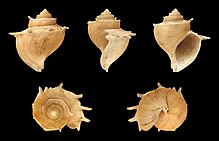| Tiphobia horei | |
|---|---|

| |
| Five views of a shell of Tiphobia horei | |
| Conservation status | |
 Least Concern (IUCN 3.1) | |
| Scientific classification | |
| Kingdom: | Animalia |
| Phylum: | Mollusca |
| Class: | Gastropoda |
| (unranked): | clade Caenogastropoda clade Sorbeoconcha |
| Superfamily: | Cerithioidea |
| Family: | Paludomidae |
| Subfamily: | Hauttecoeuriinae |
| Tribe: | Tiphobiini |
| Genus: | Tiphobia E. A. Smith, 1880 |
| Species: | T. horei |
| Binomial name | |
| Tiphobia horei E. A. Smith, 1880 | |
| Synonyms | |
|
Melania Horei E. A. Smith, 1880 | |
Tiphobia horei is a species of freshwater snail with an operculum, an aquatic gastropod mollusk in the family Paludomidae.
Tiphobia horei is the only species in the genus Tiphobia. Tiphobia is the type genus of the tribe Tiphobiini.
The specific name horei is in honor of Reverend Edward Coode Hore (1848-1912) from the UK.
Distribution and habitat
Tiphobia horei is endemic to Lake Tanganyika. It is found in Burundi, the Democratic Republic of the Congo, Tanzania, and Zambia. The type locality is Lake Tanganyika at Ujiji.
It is typically found on muddy bottoms and often near river mouths. It ranges from the shoreline to a depth of about 150 m (490 ft) but tends to be more common in deeper waters.
Description
Tiphobia horei has a large shell with spines, so it is easily to determine.
The width of the shell typically is 26 mm (1.0 in), and the height typically is 36 mm (1.4 in), but the latter can reach up to about 52 mm (2.0 in).
Tiphobia horei is ovoviviparous, there are typically almost 500 embryos per time and upon being "born" each young is up to about 1.5 mm (0.06 in) long. This snail feeds on detritus.
Conservation status
This snail was given Endangered species status in 1996, but in 2006 this was revised to Least Concern, as it was found to be widespread within the lake and at least locally common. It is facing sedimentation, dredging and shell collecting, but these are considered to be minor threats to this species.
References
- ^ Ngereza, C. (2010). "Tiphobia horei". IUCN Red List of Threatened Species. 2010: e.T21914A9340138. doi:10.2305/IUCN.UK.2010-3.RLTS.T21914A9340138.en. Retrieved 15 November 2021.
- Smith E. A. (1880). "On the shells of Lake Tanganyika and of the neighbourhood of Ujiji, central Africa". Proceedings of the Zoological Society of London 1880: 344-352. page 348, Plate 31, figure 6-6b.
- ^ Smith E. A. (1880). "Diagnoses of new shells from Lake Tanganyika and East Africa". Annals and Magazine of Natural History (5)6: 425-430. page 427.
- ^ Brown D. S. (1994). Freshwater Snails of Africa and their Medical Importance, pp. 150–151. Taylor & Francis. ISBN 0-7484-0026-5.
- Bouchet, Philippe; Rocroi, Jean-Pierre; Frýda, Jiri; Hausdorf, Bernard; Ponder, Winston; Valdés, Ángel & Warén, Anders (2005). "Classification and nomenclator of gastropod families". Malacologia. 47 (1–2). Hackenheim, Germany: ConchBooks: 1–397. ISBN 3-925919-72-4. ISSN 0076-2997.
- ^ Strong, E.E.; Glaubrecht, M. (2007). "The morphology and independent origin of ovoviviparity in Tiphobia and Lavigeria (Caenogastropoda: Cerithioidea: Paludomidae) from Lake Tanganyika". Organisms, Diversity & Evolution. 7 (2): 81–105. Bibcode:2007ODivE...7...81S. doi:10.1016/j.ode.2006.02.003.
- Palacios-Fest, M.R.; S.R. Alin; A.S. Cohen; B. Tanner; H. Heuser (2005). "Paleolimnological investigations of anthropogenic environmental change in Lake Tanganyika: IV. Lacustrine paleoecology". Journal of Paleolimnology. 34 (1): 51–71. Bibcode:2005JPall..34...51P. CiteSeerX 10.1.1.489.2218. doi:10.1007/s10933-005-2397-1.
External links
- Moore J. E. (1898). "The mollusks of the Great African lakes. 2. The anatomy of the Typhobias, with a description of a new genus (Batanalia) (sic)". Quarterly Journal of Microscopical Science 41: 181-204. Plate 11-14.
| Taxon identifiers | |
|---|---|
| Tiphobia horei | |

